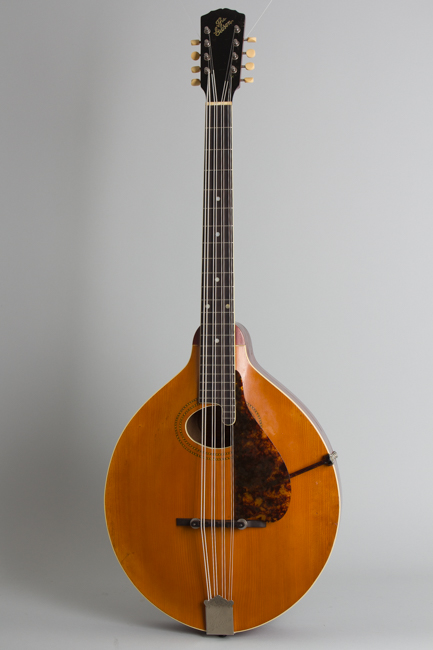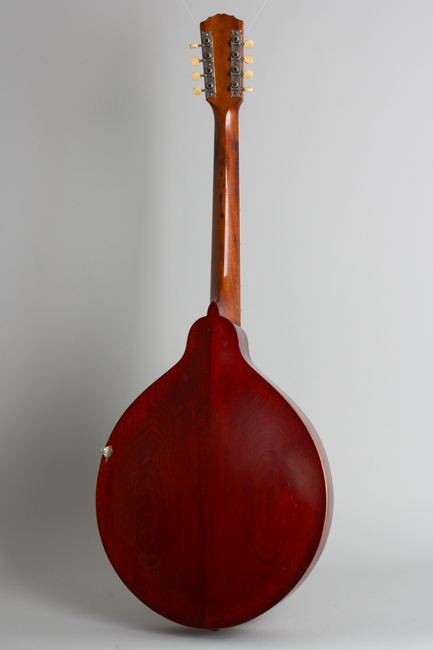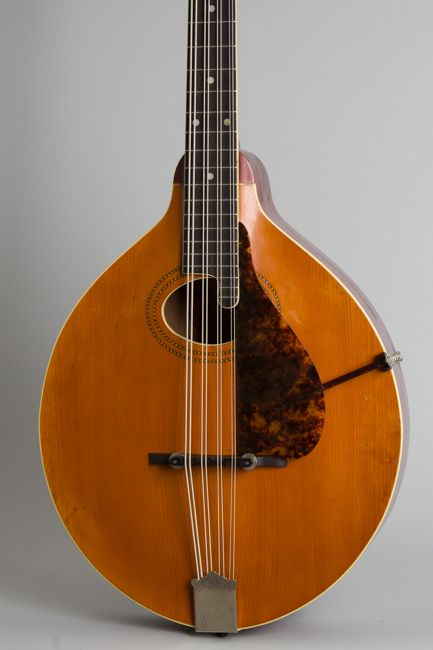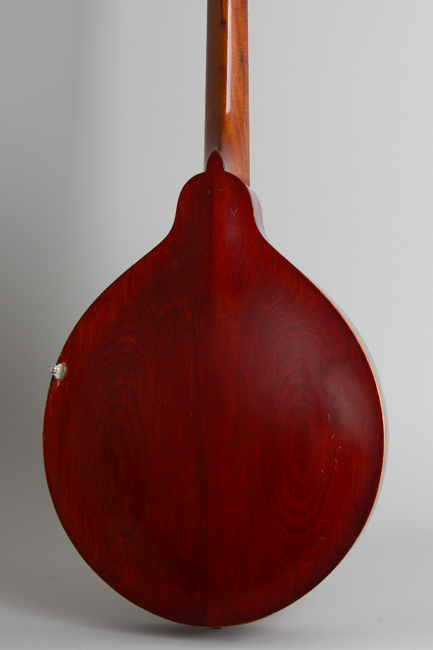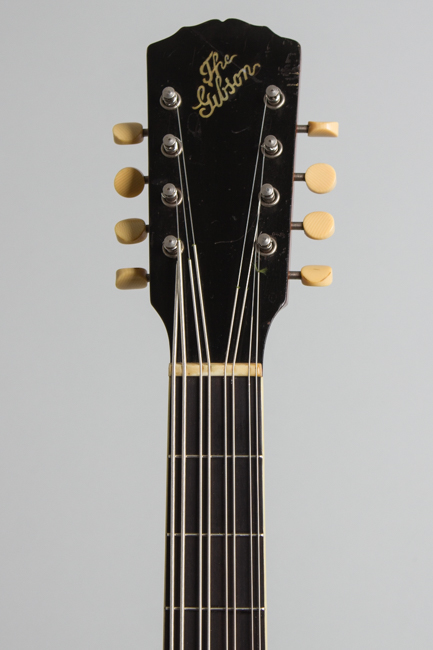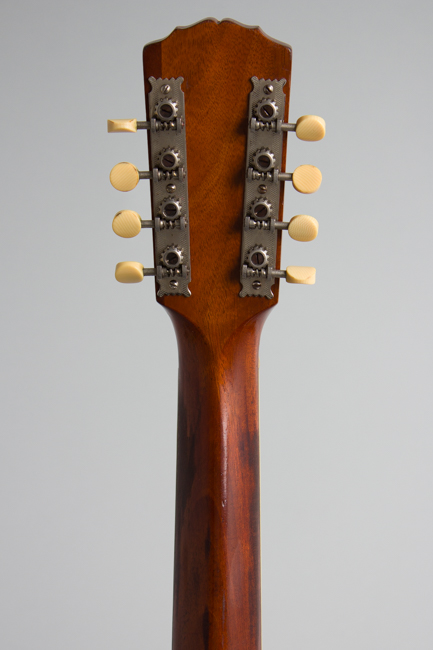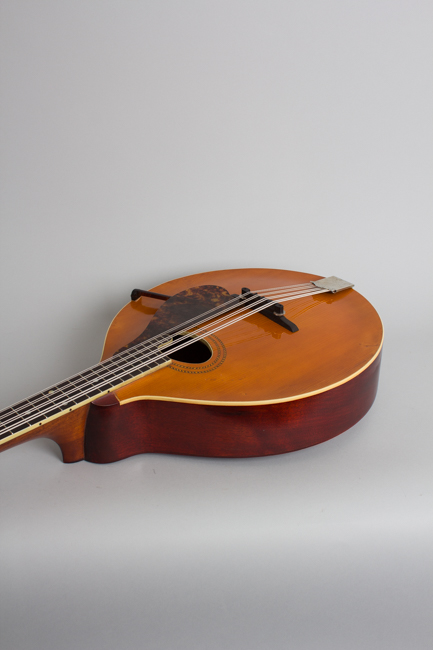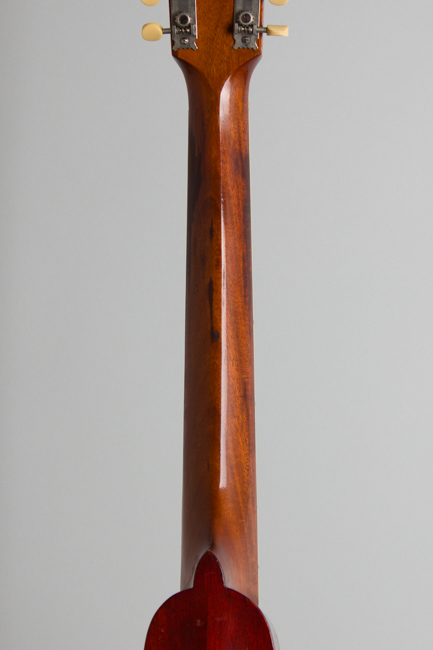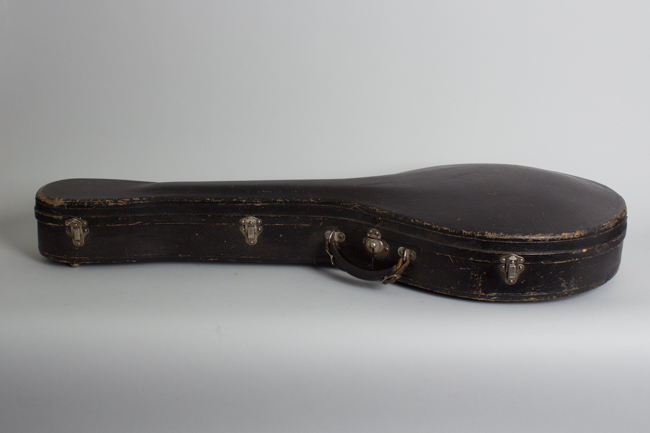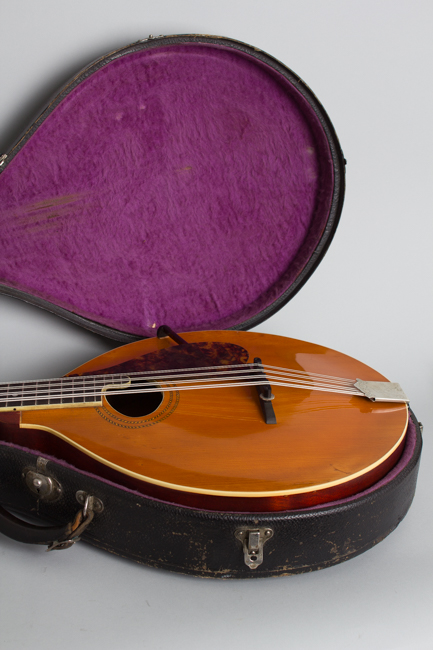Gibson K-1 Carved Top Mandocello (1915)
Gibson K-1 Model Carved Top Mandocello (1915), made in Kalamazoo, Michigan, serial # 31326, natural top, cherry stained back and sides finish, birch back and sides, spruce top; mahogany neck with ebony fingerboard, original black hard shell case.
We feel the Gibson Mandocello is one of the great under-appreciated instruments of the early 20th century. Originally designed for use in 1910s-era mandolin orchestras, these imposing beasts never found a home in any other style of music despite being wonderful and unique-sounding creations.
Double-strung and tuned in fifths starting with the C below the low E on the guitar, the mandocello has an imposing tone and deep resonance quite unlike any other fretted instrument. OK, we're starting to sound like an old Gibson catalog here, but we love these and are always happy to get one in stock!
This particular instrument is a Style K-1, the most basic of the three mandocello models Gibson offered in the 1910s but still a fairly expensive instrument when new. It is structurally the same as the fancier Model K-2 with a little less "geegaw" (decoration). The headstock face carries just a plain pearl "The Gibson" inlay while the openback strip tuners are tipped with unadorned ivoroid buttons.
The top is carved spruce with a single transverse brace just behind the soundhole. The sound hole decoration is made up of two separate half-herringbone wood inlaid rings and a bound edge. The K-2 had fancier versions of these decorative touches, but the physical features (and sound) were the same for both models, with an oval body, bound top and birch back & sides. The necks on all models are mahogany with a noticeably "V" profile neck topped by a bound, dot-inlaid ebony fingerboard.
This "Pumpkin top" K-1 Mandocello was assembled at the end of 1914 and labeled early the next year, the middle of the decade when Gibson defined the market for these mandolin family instruments. In the 1910s-'20s these Gibsons were only available from licensed teacher-agents, and were usually purchased on a time payment plan along with lessons. As part of the deal, the students would often play in the teacher's fretted orchestra, and the low-tuned mandocello was crucial to achieving a full sound in these ensembles. Far fewer were sold compared to mandolins, however, making Gibson mandocellos from any era a comparative rarity.
With its 8 strings and "C" orchestral tuning the mandocello has a totally unique sound and makes an excellent recording instrument. While mandolin orchestras are rather thin on the ground in the 21st century these instruments can be employed for a wide range of playing styles, some still yet to be explored!
Overall length is 38 7/16 in. (97.6 cm.), 14 1/8 in. (35.9 cm.) width, and 3 3/8 in. (8.6 cm.) in depth, measured at side of rim. Scale length is 24 5/8 in. (625 mm.). Width of nut is 1 5/8 in. (41 mm.).
This is a generally well-preserved example of a 110 year old K-1, and an excellent player. The original varnish finish shows far less checking than most, with mostly small dings, dents and scratches overall. There are some small old touch-ups to the top over some scratches and dents. There is a decent amount of finish worn off the back of the neck and from the treble side heel; this one did get played along the way. There are no visible crack repairs, just a slightly bulged resealed back/side seam just above the tailpiece.
All hardware is original except for the bridge, which is a more modern adjustable piece replacing the solid non-adjustable original. The tuners, tailpiece and cover and the often missing pickguard and bracket clamp are all intact. The one-piece mahogany neck has been neatly refretted and the fingerboard leveled making for an excellent playing and sounding mandocello with a big booming sound. It includes the original HSC, something almost impossible to replace if it has gone missing. Overall Excellent - Condition.
We feel the Gibson Mandocello is one of the great under-appreciated instruments of the early 20th century. Originally designed for use in 1910s-era mandolin orchestras, these imposing beasts never found a home in any other style of music despite being wonderful and unique-sounding creations.
Double-strung and tuned in fifths starting with the C below the low E on the guitar, the mandocello has an imposing tone and deep resonance quite unlike any other fretted instrument. OK, we're starting to sound like an old Gibson catalog here, but we love these and are always happy to get one in stock!
This particular instrument is a Style K-1, the most basic of the three mandocello models Gibson offered in the 1910s but still a fairly expensive instrument when new. It is structurally the same as the fancier Model K-2 with a little less "geegaw" (decoration). The headstock face carries just a plain pearl "The Gibson" inlay while the openback strip tuners are tipped with unadorned ivoroid buttons.
The top is carved spruce with a single transverse brace just behind the soundhole. The sound hole decoration is made up of two separate half-herringbone wood inlaid rings and a bound edge. The K-2 had fancier versions of these decorative touches, but the physical features (and sound) were the same for both models, with an oval body, bound top and birch back & sides. The necks on all models are mahogany with a noticeably "V" profile neck topped by a bound, dot-inlaid ebony fingerboard.
This "Pumpkin top" K-1 Mandocello was assembled at the end of 1914 and labeled early the next year, the middle of the decade when Gibson defined the market for these mandolin family instruments. In the 1910s-'20s these Gibsons were only available from licensed teacher-agents, and were usually purchased on a time payment plan along with lessons. As part of the deal, the students would often play in the teacher's fretted orchestra, and the low-tuned mandocello was crucial to achieving a full sound in these ensembles. Far fewer were sold compared to mandolins, however, making Gibson mandocellos from any era a comparative rarity.
With its 8 strings and "C" orchestral tuning the mandocello has a totally unique sound and makes an excellent recording instrument. While mandolin orchestras are rather thin on the ground in the 21st century these instruments can be employed for a wide range of playing styles, some still yet to be explored!
Overall length is 38 7/16 in. (97.6 cm.), 14 1/8 in. (35.9 cm.) width, and 3 3/8 in. (8.6 cm.) in depth, measured at side of rim. Scale length is 24 5/8 in. (625 mm.). Width of nut is 1 5/8 in. (41 mm.).
This is a generally well-preserved example of a 110 year old K-1, and an excellent player. The original varnish finish shows far less checking than most, with mostly small dings, dents and scratches overall. There are some small old touch-ups to the top over some scratches and dents. There is a decent amount of finish worn off the back of the neck and from the treble side heel; this one did get played along the way. There are no visible crack repairs, just a slightly bulged resealed back/side seam just above the tailpiece.
All hardware is original except for the bridge, which is a more modern adjustable piece replacing the solid non-adjustable original. The tuners, tailpiece and cover and the often missing pickguard and bracket clamp are all intact. The one-piece mahogany neck has been neatly refretted and the fingerboard leveled making for an excellent playing and sounding mandocello with a big booming sound. It includes the original HSC, something almost impossible to replace if it has gone missing. Overall Excellent - Condition.
